Getting Started with Organic Farming – How to Convert to Organic
20 September 2023Summary
This factsheet is the third in a series. The aim of which is to look at How to convert to Organic farming, “How to Convert to Organic” You can read the previous factsheets here “Setting the Scene” and “Is Organic for Me?”
Once you have decided that Organic is for you the first point to decide on is if you are going to seek funding to convert.
Getting Organic Certification
There are numerous certification bodies you can use to enable your business organic certification.
Regardless of what you decide, you must be certified by an approved UK organic control body if you produce, prepare, store, import, export or sell organic products in the UK. If you use a third party, they must also be certified. A link to the list is provided later in this factsheet.
The approved organic control bodies can:
- certify your business and products as organic
- advise you on importing and exporting organic food
- inspect businesses certified as organic at least once a year – this may involve sampling and testing your organic products
- approve your organic labelling
You can also report suspected issues with organic products for the control body to investigate.
Support Your Organic Conversion With AECS
Financial help to aid your business convert is available and we will look at that process now.
As we touched on our previous factsheet, conversion is likely to have an impact on the financial situation of your business. This is where gaining entry to the Agri environment climate scheme can help businesses through the conversion period with funding to aid the transition.
To convert through AECS you need to apply and with your application provide evidence with your application that conversion of the land is viable through the submission of an Organic Viability proposal (OVP). This must be endorsed from a UK-approved Organic Certification Body. You cannot formally apply for conversion of the land included in your application before the full application is submitted.
How To Submit An Organic Viability Proposal
Below is a step by step guide to prepare you for completing your OVP. The OVP is made up of the following questions:-
Provide your farm details
Your details, details of the actual farm holding that the proposal relates to and your contact details.
Prove you meet organic standards
You must obtain a copy of the standards published by a certification body within the UK (A list of approved bodies is within the link at the end of this fact sheet).
Show your proposed conversion timetable
The certification body you have chosen must formally approve your preferred date of conversion.
Outline the land area to be converted
Total areas to be converted and if applicable areas not being converted.
What is your crop rotation, proposed annual cropping and breakdown of land types?
The crop rotation is crucially important to the viability of the overall unit and organic crop, production in terms of generating fertility, and minimising weed, pest and disease problems. On rotational land, the certification body will expect you to have a balanced rotation.
What are you stocking on the proposed organic unit?
The certification body will use the information that you provide in this question, together with the land areas and details of good grass and forage, which you calculated in Questions 4 & 5, to assess whether your proposed stocking rate under organic management is feasible. Stocking rates were discussed in Factsheet 2.
What is your animal health plan?
If your conversion proposal includes livestock, you will either need to have an animal health plan or demonstrate that you are aware of how to implement such a plan.
Do you have a proposed marketing strategy
Post AECS funding, the viability of an organic farm will depend on the farmer being aware of producing what the market wants.
What To Do Post-AECS
After your AECS application is submitted you can apply to your chosen Certification Body to convert the land and they must formally approve your preferred date of conversion (which must be no earlier than 1 January of the first year of management covered in your application) and your detailed conversion plan.
Additionally, you must note that if your application is approved you must begin conversion by either within six months from the date of your authority to start work letter or your contract start date (usually 1 January) whichever is the later.
| Organic conversion payment rates per hectare | ||
|---|---|---|
| Conversion rates per ha | Years 1 – 2 | Years 3 - 5 |
| Arable | £280 | £65 |
| Improved Grassland | £140 | £55 |
| Unimproved Grassland/ Rough Grazing | £12.50 | £8.50 |
| Fruit & Vegetables | £400 | £200 |
Next steps
As mentioned above you need to obtain a list of standards and the link below shows all the UK approved control bodies:-
https://www.gov.uk/guidance/organic-food-uk-approved-control-bodies#organic-food-federation
More information on funding for conversion under AECS is below:-
https://www.fas.scot/discussion-groups/organics/organics-podcasts/
Sign up to the FAS newsletter
Receive updates on news, events and publications from Scotland’s Farm Advisory Service

